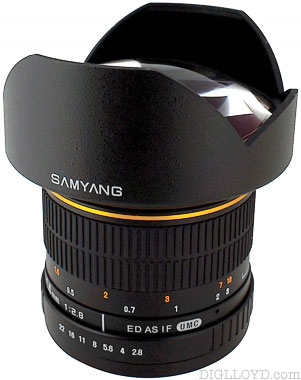EXCERPT page containing first few paragraphs. 2024-04-18 17:18:47
UA_SEARCH_BOT_null @ 18.119.133.228
For full access, subscribe here. Or click title to login. ![]()
Case Study: Severe Lens Skew (D800E, Samyang 14mm f/2.8)
The Samyang 14mm f/2.8 was shot here with the 36-megapixel Nikon D800E.
The example shown here is with a Nikon D800E given special attention per my request to Nikon service following my detection of some minor sensor-to-flange alignment hints that I saw with several lenses
Preface
It is not uncommon for even a well made lens to have a slight left/right asymmetry across the frame, especially as focus changes; those elements have to move and they can never be assembled absolutely perfectly nor can they rotate and move in absolutely perfect planar fashion down to the last micron of precision. Lenses with manual focus helicoids and autofocus lenses all show the issue; see for example the Sigma 120-300mm example. Furthermore, lens elements have to be ground to some degree of precision, and small variations mean that there is always natural variation here and there, especially as those elements are rotated. Perhaps only the ultra expensive cine lenses avoid the issue (presumably), by virtue of exacting quality control standards.
Article continues for subscribers...
Diglloyd Making Sharp Images is by yearly subscription. Subscribe now for about 13 cents a day ($50/year).
BEST DEAL: get full access to ALL 8 PUBLICATIONS for only about 75 cents a day!
Diglloyd Making Sharp Images articulates years of best practices and how-to, painstakingly learned over a decade of camera and lens evaluation.
Save yourself those years of trial and error by jump-starting your photographic technical execution when making the image. The best lens or camera is handicapped if the photographer fails to master perfect shot discipline. High-resolution digital cameras are unforgiving of errors, at least if one wants the best possible results.
- Eases into photographic challenges with an introductory section.
- Covers aspects of digital sensor technology that relate to getting the best image quality.
- Technique section discusses every aspect of making a sharp image handheld or on a tripod.
- Depth of field and how to bypass depth of field limitations via focus stacking.
- Optical aberrations: what they are, what they look like, and what to do about them.
- MTF, field curvature, focus shift: insight into the limitations of lab tests and why imaging performance is far more complex than it appears.
- Optical aberrations: what they are, what they look like, and what to do about them.
- How to test a lens for a “bad sample”.
Intrigued? See Focusing Zeiss DSLR Lenses For Peak Performance, PART ONE: The Challenges, or (one topic of many) field curvature.



